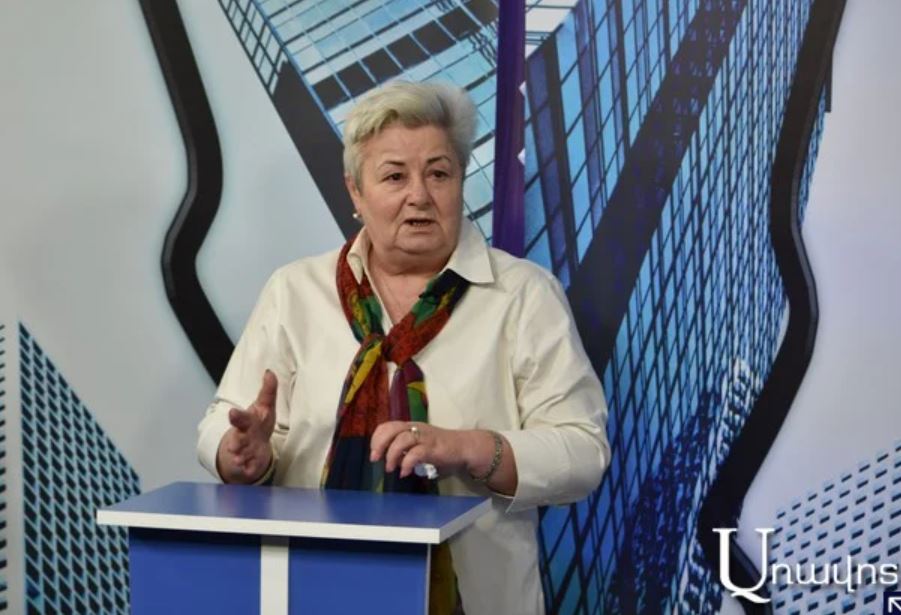At the conference on “Old and New Refugees of Azerbaijani Aggression, Past, Present, Future,” ethnographer Hranush Kharatyan presented the historical facts about the causes of refugees in the South Caucasus and the actions of Turkic-speaking organizations.
According to Kharatyan, at the end of the 19th century and in the 20th century, the most important conflict problem was the use of resources in the South Caucasus and especially in its eastern part, as well as the Turkic-speaking groups living in the territory of Georgia and Armenia, were herders, it was an essential source of their life, which required seasonal to live in the mountains in the summer and in the plains in the winter. In between were the settlements of the peoples of the Caucasus, which were from the plains, the foothills, and the mountains, even before Turkification, due to the security considerations of the Caucasus. These seasonal shifts destroyed farmers’ farms.
That has been the most important reason for conflicts, and there have been constant conflicts, including military ones, to take over this resource. According to the historical facts presented by Kharatyan, in 1905-07, the first conflict took place: “At that time, very heavy Armenian-Shiite-Muslim conflicts took place, which were accompanied by the forced Muslimization of local Christian peoples, the process of identity change, in the early period of the formation of Turkish and later Azerbaijani identity. These were actions that were activated on the way to creating an identity. The Azerbaijani identity of the Turkic-speaking tribes began to be formed by contrasting the identities of the peoples living in that area of the Caucasus. There was a lot of hatred and enemy-seeing in this. There was also the opposite.
Read also
From the beginning of the 20th century until today, this was accompanied by a racist, sometimes even close to fascist, attitude towards their neighbors. 1905-07 the heaviest burden of these actions was borne by the Armenians and those peoples who, according to Kharatyan, were declared destroyed in Azerbaijan after the sixties; they were those who reached from Aghvank to the mentioned area, the Lezgi-speaking peoples. There are about ten Lezgi-speaking peoples in the territory of Azerbaijan whose names are unknown to the world because, as the ethnographer said, they do not exist in the official censuses of Azerbaijan. Continuing to present historical documentary episodes, Kharatyan noted.
“Imagine that country that tries to present itself to the world as multinational and international; in that country, many peoples with their languages, names, and identities simply do not exist in their historical homeland of thousands of years. No international monitoring finds them; their names are not registered anywhere, only sometimes they are in expert texts or experts know about them,” Kharatyan said.
In the 19th century, the Udis wrote on their tombstones that they were Enlightenment from a Udi-speaking tribe adjacent to the Armenian Apostolic Church, and these, as Kharatyan noted, are something like a passport for them: “Azerbaijan wants to convince the world that Armenians Gregorize the Udis.” are, that is, those people have been following one religion for 2000 years, and now the Armenians are bringing them to another religion and dissolving them. It seems absurd, but it is a significant political move and is close to racism in many ways. Those Udis were massacred in 1905-1907, 1918-1920, suppressed, and pushed out of the Soviet period. In 1988-89, together with the Armenians, they were subjected to the same violence as the Armenians of Baku and Sumgait. Everyone became a refugee.
Today, about 2,000 people live in Shaki, the homeland of the Udis, and they have become a political toy in the hands of the Azerbaijani dictatorship because it must be argued that the Aghvan people were constantly assimilated as a result of Armenian aggression. In all the historical and cultural monuments of the Shaki area, there is not a single line about the Aghvanian past and the Udi heritage. It is an example that this country is dangerous for the entire Caucasus.
Now it seems that the Armenian-Azerbaijani relations are very active. Still, the Azerbaijani identity is claimed by the people of South Dagestan, the people of their bordering part of Georgia, and until this mentality or maybe indeed that ethnicity is polished, there will be refugees and discussions about this refugee. The world should try to stop this process.”
Nelly BABAYAN


























































